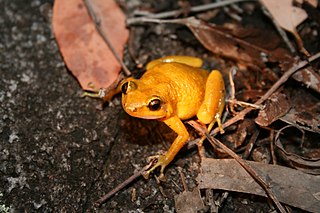
The common rock thrush, also known as rufous-tailed rock thrush or simply rock thrush, is a chat belonging to the family Muscicapidae. It was formerly placed in the family Turdidae. The scientific name is from Latin. Monticola is from mons, montis "mountain", and colere, "to dwell", and saxatilis means "rock-frequenting", from saxum, "stone".

The rock partridge or common rock partridge is a gamebird in the pheasant family, Phasianidae, of the order Galliformes. It is native to southern Europe, and is closely related and very similar to its eastern equivalent, the chukar partridge, A. chukar.

The sergeant major or píntano is a species of damselfish. It grows to a maximum length of about 22.9 centimetres (9.0 in).

The scrub hare is one of two species of hares found in southern Namibia, Mozambique, South Africa, Eswatini and Lesotho. Although it is listed as a least concern species, the population has been declining and is expected to decline by 20% over the next 100 years.

The Indo-Pacific sergeant is a species of damselfish in the family Pomacentridae. It may also be known as the Sergeant major although this name is usually reserved for the closely related species Abudefduf saxatilis. The closely related Abudefduf caudobimaculatus was formerly considered to be synonymous with this species and, according to some authorities, is synonymous.
Eleutherodactylus saxatilis is a species of frog in the family Eleutherodactylidae. It is endemic to Mexico. Its natural habitats are subtropical or tropical moist lowland forests and rocky areas. It is threatened by habitat loss.
Thoropa saxatilis is a species of frog in the family Cycloramphidae. It is endemic to southern Brazil and occurs in the Santa Catarina and Rio Grande do Sul states, corresponding to the southernmost extent of the Atlantic Forest biome. The specific name saxatilis refers to its association with rocks. Common name Brazilian river frog has been coined for it.

The Black Mountain boulder frog, also known as the rock haunting frog or the Black Mountain rainforest frog, is a species of frog in the family Microhylidae.
The mole toadlet is a species of frog in the family Myobatrachidae. It is endemic to Western Australia. Its natural habitats are dry savanna and subtropical or tropical dry lowland grassland.

Tacinga braunii is a species of plant in the family Cactaceae. It is endemic to Eastern Brazil where its distribution is restricted to the north-eastern region of Minas Gerais in the valley of the river Jequitinhonha, where it grows on gneiss or granite rock outcrops. It is pollinated by hummingbirds. Its natural habitats are subtropical or tropical dry forests and hot deserts. It is threatened by habitat loss.

Tacinga palmadora is a species of plant in the family Cactaceae. It is endemic to Brazil. Its natural habitats are subtropical or tropical dry forests and subtropical or tropical dry shrubland. It is threatened by habitat loss.

Tacinga werneri is a species of plant in the family Cactaceae. It is endemic to Brazil. Its natural habitats are subtropical or tropical dry forests and hot deserts. It is threatened by habitat loss.

Saxatilomys paulinae is a species of murid rodent native to central Laos and Vietnam, separated to a monotypic genus Saxatilomys. It was first discovered in the Khammouan Limestone National Biodiversity Conservation Area in Khammouan Province, Laos, and also been found in the Vietnamese province of Quang Bình. It is the only known species in the genus Saxatilomys. The genus name is derived from the Latin saxatilis, meaning "among the rocks" and the Greek mys, meaning mouse or rat.

Parmelia saxatilis, commonly known as the salted shield lichen or crottle, is a species of foliose lichen in the family Parmeliaceae. Several morphologically similar species, formerly lumped together, are now distinguished by their DNA.

The black rock skink is a species of large skink native to Eastern and Southern Australia from central New South Wales to Grampians National Park in Victoria. A large, dark colored skink, up to 135 mm from snout to base of the tail, the black rock skink is the first reptile discovered to have a "nuclear family" structure where the parents form a pair and care for their offspring for more than one year. The black rock skink is a viviparous skink meaning females give birth to live offspring instead of laying eggs. They defend their home range and families against conspecifics for up to several years.
Pandanus aridus is a species of shrub or small tree in the family Pandanaceae. It is native and endemic to Madagascar, found in fragmented locations in the southern third of the country. Pandanus aridus H. St. John is the accepted name, with a synonym of Pandanus toliarensis Huynh.
The stony-soil ctenotus is a species of skink found in Northern Territory, South Australia, and Western Australia.












